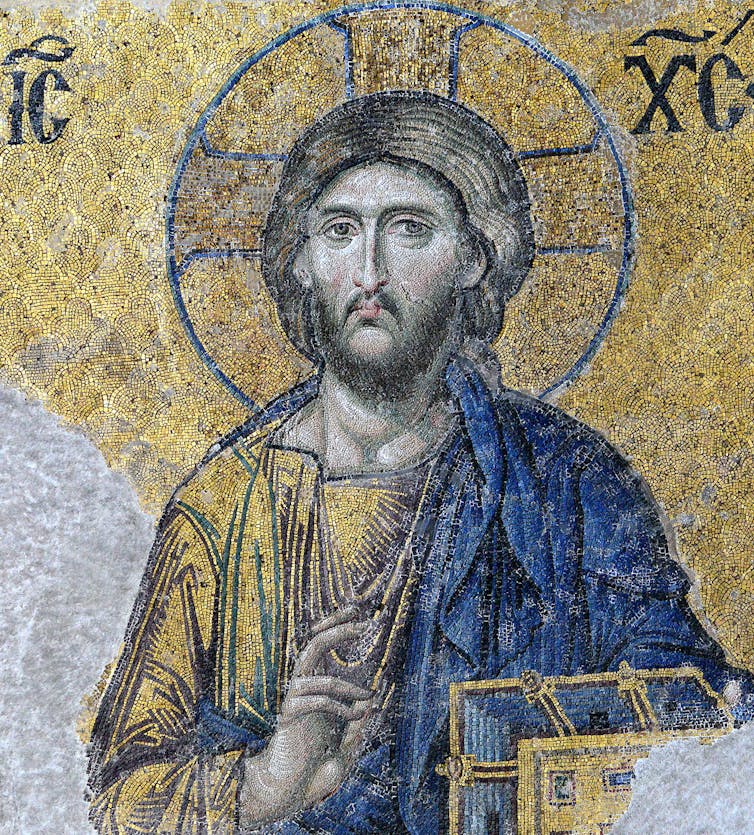(The Conversation) — In 1915, Norwegian artist Emanuel Vigeland, one of the most respected Scandinavian artists of his time, created an image of Christ with golden hair and fair skin.
Vigeland was well aware of a widely popular Bible illustrated by French artist James Tissot showing Christ as Middle Eastern with dark hair and brown skin. Tissot had spent many years in the Holy Land in the late 19th century, researching the “historical Jesus” as part of a new group of artists looking for historical accuracy.
Vigeland, however, was seeking a different tradition, one that saw a picture of Christ not as a photographic truth but as an image that communicated to the Norwegian community that Jesus was a brother.
Vigeland shows a handsome youth in front of a landscape of the New Jerusalem as described in the Bible. He used the elegant style of the day, art nouveau, to appeal to his modern community, helping the Norwegian onlooker bond with the image.
In my work as a religious history scholar, I’ve learned that throughout history artists created images of Christ that would speak to different communities.
Early image of Christ as a symbol
Sometimes, cultural pressures prevented people from representing Christ at all. In ancient Rome, early Christians often favored symbols or monograms of Christ’s name, possibly because they did not want to confuse Christ’s image with that of the emperor.
Figural representations became more popular in the fourth century, but symbols were still used. A stone sarcophagus in the Vatican Museums, for example, shows events leading up to Christ’s death. In the center, however, Christ’s triumphant resurrection from the dead shows only his cross surmounted with the monogram of Christ. It consists of the first two capital letters, Χ and Ρ – called chi and rho – of the Greek word for Christ: ΧΡΙΣΤΟΣX.
Christ with 2 natures

Christ at the Hagia Sophia in Istanbul.
Michel M. Raguin, CC BY
The monumental Hagia Sophia in Constantinople – now Istanbul – was originally constructed as a cathedral. Built in 537 by the emperor Justinian, it was at first without figural imagery. About 300 years later, several pictures in mosaic were added – one attesting to the cathedral’s tradition of deep theological study.
It copies a revered icon housed in the monastery of St. Catherine on Mount Sinai, Egypt. The icon, most likely created in Constantinople as a gift to the monastery by Justinian, shows unusual asymmetry to signify Christ’s dual nature as both God and man. The two sides of Christ’s face are not the same, and the differences were meant to demonstrate his human nature and his divinity. Although different, both were truly joined in one body.
These were commissioned by the cathedral’s scholars in keeping with representing Christian mysteries and preserving tradition.
Christ as a god and child

A folio depicting scenes from the life of Christ and four portraits of the Evangelists introducing the respective Gospel texts.
Illuminated Gospel, Amhara peoples — late 14th-early 15th century. Metropolitan Museum New York.
An Ethiopian book of the Gospels depicted Christ as eternally young, even as he wields all power on heaven and earth. In a way, it is similar to Vigeland’s image of the youthful ruler.
Christianity came to Ethiopia in the fourth century. From that time, Ethiopia continued to use abstracted forms to convey the mystery of Christ who lived and died yet also lives eternally. The manuscript’s illustration of the Ascension – Christ’s return to his father in heaven after his resurrection – depicts him as a child, holding a book in a circle of red.
He is surrounded by the winged symbols of the four Evangelists: Matthew (man), Mark (lion), Luke (bull) and John (eagle). Below, Christ’s disciples point upward to verify his ascension into glory. Their bold colors and powerful abstraction prefigure the paintings of Picasso – a demonstration that art, like Christ, can be both deeply of its time and beyond.
(Virginia Raguin, Distinguished Professor of Humanities Emerita, Visual Arts, College of the Holy Cross. The views expressed in this commentary do not necessarily reflect those of Religion News Service.)
![]()





